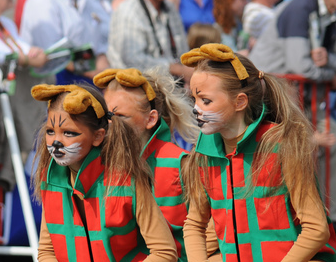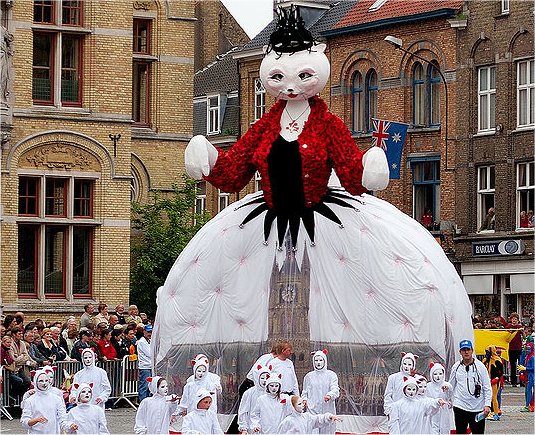Kattenstoet – the Cat Festival

The Middle Ages were not kind to cats. In the fifteenth century a papal decree known as the Vox in Rama declared that the devil was known to manifest itself in the form of a black cat. While the decree did not specifically say that all black cats were diabolical, the decree was bad news for dark cats. At this time the church was also keen on having humans burned at the stake for any signs of heresy, and having a black cat was a pretty good sign of heresy.
Even non-black cats were treated badly, even by the very low standards of medieval Europe. A good example of this was in the city of Ypres in Belgium. Ypres is now famous for the WWI battle fought nearby, but in the Middle Ages it was a center of the cloth industry, weaving fine garments from cloth imported from England. Both the wool and the finished cloth were stored in 'Cloth Halls', where, given Medieval standards of sanitation, the product rapidly became infested with mice.
Since mouse droppings and gnawed fabric do not do much for a product's value, the city council invested in some cats to control the mice. However, perhaps to prove that the the council had no satanic intentions behind this pest-control measure, once the cloth was sold, the cats were killed. They were not just put down, but taken to the local church and hurled from the bell tower. This happened on 'Cat's Wednesday', in the second week of Lent. What is interesting is that for all this eagerness to avoid looking satanic, there seems to have been an element of Pagan sacrifice in the ritual killings. When the cloth sales were good, only a few cats were killed, when sales were poor, more cats were 'sacrificed'.
This barbaric practice continued for centuries – from at least 1410 to the last ritual killing in 1817. A local archivist saw the very last cat to be thrown off the tower. The cat not only survived the fall, but as soon as it hit the ground, it ran for its remaining eight lives. Thereafter the ceremony dropped into obscurity, celebrated only by the ringing of the bells on 'Cat Wednesday'.
In the 1930s cats were again thrown from the bell-tower in Ypres. But now the cats were soft plastic toys thrown as part of an expanded city festival which also featured a 'Cat's race' in the morning by competitors on bicycles. Since then the event has been expanded into a parade and full-scale festival which happens once every three years. Despite setbacks caused by war and recessions, Cat's Wednesday is now a well-established event which celebrates cats rather than killing them.
At the parade, tableaux show themes such as 'Cats in Language and History', 'World Cats' or the show celebrates Ypres' new image as a Cat City. During the festival, shop windows fill with cat-themed decorations and toys, and almost every foodstuff imaginable is sold in cat-shape. Of course, toy cats are still thrown from the bell tower, but now they are plushy toys which are eagerly caught by the children gathered below. In the parade itself many people dress as cats or witches, and during the celebrations the Medieval superstitions are mocked by the burning of a dummy 'witch'.

Cat Wednesday is not now celebrated just by cat lovers - the festival has become a popular tourist attraction. In fact the city has a website dedicated to the Kattenstoet which can be found here.
The world needs more cat celebrations. And while the Ypres celebration is a wonderful festival, it is worth noting that the city has still 350 years of shameful behaviour to make up for! Next parade 2018 ...
Pictures:
1. Detail from 'Kattenstoet '09 Ieper' by GeS
2. 'Minneke Poes' by cirdub
Creative Commons Attribution

